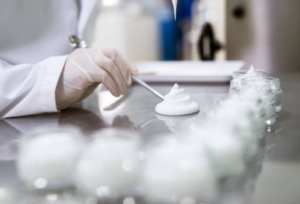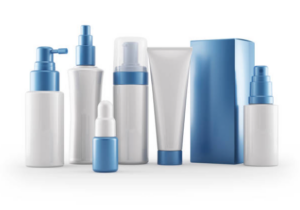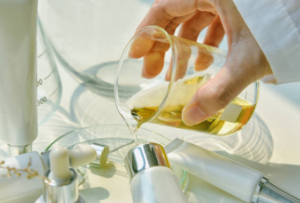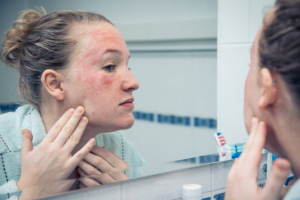Are They Sabotaging Your Complexion?

In the realm of skincare, it seems that new ingredients are constantly making headlines, promising to be the next big thing for flawless skin. Among these ingredients are PEGs, which you may have come across in the ingredient list of your favorite skincare products. But what are PEGs, and should you be concerned about their presence in your beauty routine? In this comprehensive guide, we’ll delve deep into the world of PEGs in skincare, exploring their roles, potential benefits, and controversies to help you make informed decisions about what goes on your skin.
Understanding PEGs
Polyethylene glycols, commonly known as PEGs, are synthetic polymers derived from ethylene oxide, a petroleum-based compound. They belong to a class of chemicals called “polyols” and have a wide range of applications in various industries, including cosmetics and skincare.
PEGs are created through a chemical process called polymerization. Ethylene oxide molecules are combined to form long chains of PEGs, and the number at the end of “PEG” (e.g., PEG-8, PEG-100) indicates the size or molecular weight of the polymer. Different molecular weights of PEGs serve different purposes in skincare formulations. For example, lower molecular weight PEGs are used as emulsifiers, while higher molecular weight PEGs may function as thickeners or humectants.
There is a wide variety of PEG compounds used in skincare products, each with its unique properties and functions. Here are some common types of PEGs you may encounter:
- PEG-8 and PEG-12: These lower molecular weight PEGs are often used as emulsifiers to blend oil and water-based ingredients in products like cleansers and lotions.
- PEG-100: This higher molecular weight PEG can serve as a thickener in skincare formulations, helping to create creamy textures in creams and moisturizers.
- PEG-40 Hydrogenated Castor Oil: This PEG derivative is commonly used in makeup removers and cleansing oils as an emulsifier and solubilizer, enabling the removal of oil-based makeup and impurities.
- PEG-20 Glyceryl Triisostearate: This PEG compound is often found in cleansing balms and makeup removers, contributing to their texture and cleansing properties.
- PEG-7 Glyceryl Cocoate: Used in gentle cleansers and foaming products, this PEG derivative functions as a surfactant and emulsifier, helping to remove dirt and makeup.

The Potential Benefits of PEGs in Skincare
- Improved Product Texture:
- One of the primary benefits of PEGs in skincare is their contribution to the texture and consistency of products. PEGs can create a smooth and velvety texture that enhances the application and spreadability of skincare formulations.
- The lightweight and non-greasy feel of PEG-based products makes them comfortable to wear, especially in moisturizers, serums, and sunscreens.
- Stability:
- PEGs play a vital role in stabilizing skincare formulas. They help prevent the separation of ingredients, ensuring that the product remains homogenous and effective over its shelf life.
- Skincare products that contain active ingredients, such as antioxidants or retinoids, often rely on PEGs to maintain the integrity and potency of these actives.
- Even Distribution:
- PEGs contribute to the even distribution of ingredients within a skincare product. This means that when you apply the product to your skin, you’re more likely to receive a consistent dosage of active ingredients, resulting in more predictable and reliable results.
- The even distribution of ingredients can lead to a more balanced and uniform application, reducing the risk of patchy or uneven coverage.
- Enhanced Penetration of Actives:
- In some formulations, PEGs can serve as penetration enhancers, helping active ingredients to better penetrate the skin’s barrier. This can be particularly advantageous for products containing beneficial compounds like hyaluronic acid, vitamins, or peptides.
- By improving the penetration of these active ingredients, PEGs can potentially enhance the efficacy of skincare products, leading to more visible and rapid results.
- Customizable Formulations:
- PEGs are versatile, allowing formulators to tailor skincare products to meet specific needs. They can be used in a wide range of skincare formulations, from lightweight serums to rich creams, providing flexibility in creating products suitable for different skin types and concerns.
- Hydration and Moisture Retention:
- Some PEGs, especially those with higher molecular weights, act as humectants, helping to attract and retain moisture in the skin. This property can be beneficial for individuals with dry or dehydrated skin, as it helps lock in hydration.
- Improved Spreadability and Blendability:
- The presence of PEGs in skincare products ensures that the product glides smoothly across the skin, making it easier to apply and blend. This can be especially important for products like sunscreens, ensuring even coverage and protection.
While PEGs offer several advantages in skincare, it’s essential to keep in mind that the benefits may vary depending on the specific PEG compound used and the formulation of the product. Not all PEGs are created equal, and their effectiveness can be influenced by factors such as their molecular weight, concentration, and the presence of other ingredients in the formulation.
Ultimately, when considering skincare products containing PEGs, it’s essential to assess your skin type, preferences, and any potential sensitivities. Additionally, consulting with a dermatologist or skincare professional can help you determine which products with PEGs align with your skincare goals and needs.

Should You Be Concerned?
PEGs have become a subject of controversy and concern within the skincare community. While they offer various benefits, there are valid reasons for individuals to be cautious about their use in skincare products. Here are some of the key issues associated with PEGs:
- Potential Contamination:
- One of the primary concerns is the potential for PEGs to be contaminated with harmful impurities during the manufacturing process. Ethylene oxide and 1,4-dioxane, both of which are considered potentially harmful compounds, may remain as impurities in some PEGs.
- Ethylene oxide is classified as a known human carcinogen by the International Agency for Research on Cancer (IARC), and 1,4-dioxane is considered a possible human carcinogen. While the levels of these impurities in skincare products are typically low, their long-term exposure can raise safety concerns.
- Skin Sensitivity:
- Some individuals with sensitive skin may experience irritation when using products containing PEGs. This can manifest as redness, itching, burning sensations, or contact dermatitis.
- Skin reactions to PEGs are more likely to occur when higher molecular weight PEGs are used in products applied to sensitive areas, such as the face. Individuals with a history of skin sensitivity should exercise caution when choosing products that contain PEGs.
- Penetration Enhancement:
- While the ability of PEGs to enhance the penetration of active ingredients into the skin can be beneficial for some skincare products, it can also raise concerns. This property can increase the absorption of not only beneficial ingredients but also potential impurities and toxins present in the formula.
- When PEGs enhance the penetration of other substances, there is the potential for the skin to absorb ingredients that may not be suitable or safe for prolonged exposure.
- Environmental Concerns:
- The production and disposal of PEGs can have environmental implications. Ethylene oxide, a key component in the production of PEGs, is classified as a hazardous air pollutant by the U.S. Environmental Protection Agency (EPA).
- Additionally, PEGs are non-biodegradable, which means they can persist in the environment for extended periods, potentially affecting ecosystems and water sources.

Navigating PEGs in Skincare: What to Consider
Considering the controversy surrounding PEGs, here are some factors to keep in mind when evaluating skincare products:
Ingredient Transparency: Look for brands that prioritize ingredient transparency. Brands that disclose the source and purity of their PEGs, as well as the absence of harmful impurities, provide consumers with more information to make informed choices.
Patch Testing: If you have sensitive skin or have experienced skin sensitivities in the past, it’s advisable to perform a patch test when introducing products containing PEGs. Apply a small amount of the product to a discreet area of your skin and monitor for any adverse reactions.
Consult a Dermatologist: If you have concerns about using products with PEGs or have experienced skin reactions, consult a dermatologist or skincare professional. They can provide guidance on suitable products and ingredients tailored to your skin’s needs.
Choose PEG-Free Alternatives: If you prefer to err on the side of caution, explore skincare products that are formulated without PEGs or opt for natural and organic alternatives. Many brands offer PEG-free options that may align better with your skincare philosophy.
PEGs are indeed versatile ingredients that contribute to the texture, stability, and effectiveness of many skincare products. However, they are not without controversy, and some individuals may be more sensitive to their presence than others. When it comes to PEGs in skincare, knowledge is power. By understanding their roles and potential risks, you can make informed choices about the products you use and their impact on your complexion. Ultimately, the decision to include or avoid PEGs in your skincare routine should be based on your unique skin type, concerns, and preferences.

